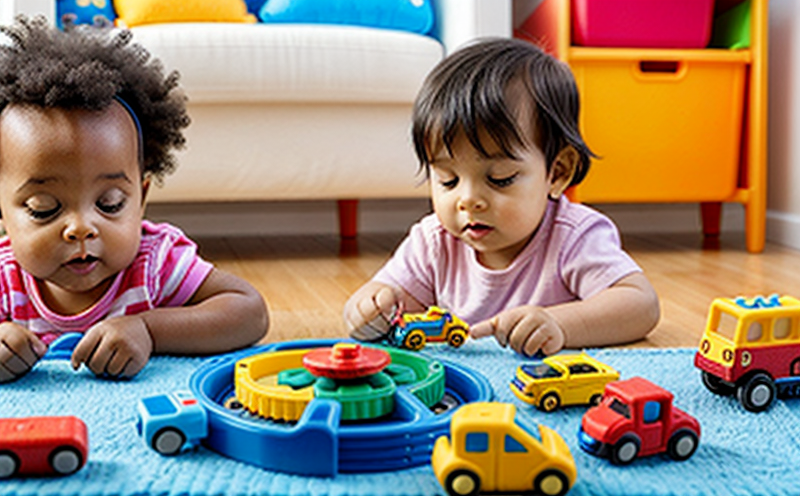Verifying that small parts meet safety criteria for toys and products intended for infants and toddlers
Ensuring Safety for Little Ones Verifying Small Parts Meet Critical Criteria with Eurolab
As a manufacturer of toys and products intended for infants and toddlers, you understand the importance of ensuring that your creations are safe for their young consumers. In todays competitive market, its not enough to simply meet regulatory requirements; you must exceed them to stand out as a leader in the industry. One crucial aspect of toy safety is verifying that small parts meet critical criteria, a laboratory service provided by Eurolab.
What is Verifying Small Parts Meet Safety Criteria?
Verifying that small parts meet safety criteria for toys and products intended for infants and toddlers involves conducting thorough tests to ensure that any detachable parts are designed with the childs safety in mind. This includes evaluating the size, shape, and material of small components to prevent them from becoming detached or posing a choking hazard.
The Importance of Small Part Safety
According to the U.S. Consumer Product Safety Commission (CPSC), over 12,000 children visit emergency rooms each year due to toy-related injuries. A significant percentage of these incidents involve ingestion of small parts, such as beads, marbles, and coins. By verifying that your products meet critical safety criteria, you can
Reduce the risk of product liability lawsuits
Protect your brand reputation by demonstrating a commitment to safety
Meet regulatory requirements, including those set by the CPSC and European Unions (EU) EN 71 standard
Advantages of Using Eurolabs Verifying Small Parts Meet Safety Criteria Service
Our laboratory service provides numerous benefits for manufacturers, including
Key Benefits
Compliance with regulations Our experts ensure that your products meet or exceed industry standards, reducing the risk of non-compliance and associated fines.
Enhanced product safety By verifying small parts meet critical criteria, you can provide parents and caregivers with peace of mind, knowing their little ones are safe when using your products.
Cost savings Avoiding costly recalls, lawsuits, and reputational damage by investing in our laboratory service can save you significant resources.
Competitive advantage Demonstrating a commitment to safety sets your brand apart from competitors, appealing to customers seeking trustworthy products.
How Eurolabs Service Works
Sample submission Send us the small parts or toys you wish to have tested.
Testing and evaluation Our experts conduct thorough examinations of each part, assessing size, shape, material, and potential detachment risks.
Reporting and certification We provide detailed reports outlining test results and any necessary modifications for compliance.
QA Frequently Asked Questions
Q What types of products require small part safety testing?
A Toys and products intended for infants and toddlers, such as pacifiers, teethers, and rattles, require special attention to ensure small parts meet critical criteria.
Q How long does the testing process take?
A The duration of our laboratory service varies depending on the complexity of the product. Typically, results are available within 3-5 business days.
Q Can Eurolabs service help me avoid recalls and lawsuits?
A Yes! Our expertise ensures that your products meet or exceed industry standards, significantly reducing the risk of product liability issues.
Conclusion
Ensuring small parts meet safety criteria for toys and products intended for infants and toddlers is a critical aspect of regulatory compliance and business success. Eurolabs laboratory service provides manufacturers with peace of mind by verifying their products meet industry standards. By partnering with us, you can
Protect your brand reputation
Reduce the risk of product liability lawsuits
Meet or exceed regulatory requirements
Dont take chances with toy safety choose Eurolab for expert verification services and give yourself (and parents) the confidence that comes with knowing your products are designed with little ones well-being in mind.
-
Evaluating the safety of small parts in consumer products to prevent choking hazards for children
-
Testing for the potential risk of small parts becoming detached from products during use
-
Simulating conditions where small parts may become dislodged or separated from consumer goods
-
Assessing the size and design of small components in products to ensure they are safe for all users
-
Testing the durability of small parts under stress or wear conditions to prevent breakage or loss
-
Evaluating the attachment mechanisms of small parts, such as buttons, caps, or fasteners, to prevent detachment
-
Testing for compliance with safety standards related to small parts in children's toys, clothing, and household goods
-
Simulating real-world handling of products to assess if small parts pose risks of ingestion or injury
-
Assessing the likelihood of small parts becoming loose or hazardous during transportation or shipping
-
Testing for the mechanical integrity of small parts to ensure they withstand regular use without breaking
-
Evaluating the design and placement of small parts to prevent potential safety issues in products
-
Simulating exposure to environmental factors like moisture, heat, or pressure to test small part durability
-
Testing for sharpness or pointed edges in small parts that could lead to injury
-
Assessing the potential for small parts to cause malfunction or failure in electronic devices or appliances
-
Testing for small parts that may become hazards in items like household tools, office supplies, and toys
-
Verifying the safety of products that include removable or detachable small parts
-
Ensuring that small parts are securely fastened and do not pose a risk of detachment during product life
-
Testing small parts in products designed for medical or personal care to ensure safety and reliability
-
Simulating accidental impacts to assess the potential for small parts to dislodge and cause harm
-
Evaluating the consumer education needed to mitigate risks from small parts in products intended for children




